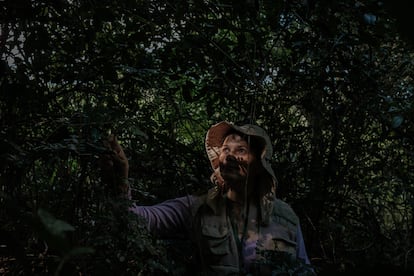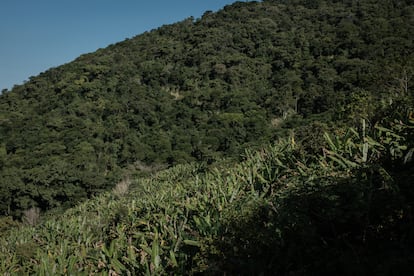The tree that gave Brazil its name almost became extinct after the Portuguese conquest. This biologist wants to rescue it
Patricia da Rosa is determined to find out how many specimens of Brazilwood are left. Almost eradicated in the 16th century because of its value as a dye, the species is still endangered today

“Red as coals, brasil.” The bright red color of its wood was responsible for the name of the tree, and later, the country. When the Portuguese conquistadors began to explore the rainforest of the Atlantic coast, they soon came across a tree whose reddish wood could be used to dye fabrics. The tree’s fibers that resembled embers (brasas in Portuguese) could produce the brilliant scarlet red coveted by the kings and aristocrats in half of Europe. The discovery of the Brazilwood (Paubrasilia echinata) dye triggered a frenzy and the tree began to be cut down on a massive scale. Those who traded the wood began to be called brasileiros, (Brazilians). More than 500 years later, other Brazilians are now struggling to resurrect the species. Among them is Patricia da Rosa, a biologist and botanist at the State University of Rio de Janeiro (UERJ) who has set out to get a general overview of the species’ condition, to find out how many are left in order to understand what can be done to save them.
Accompanying her on one of her expeditions is not an easy thing to do. In the Pedra Branca mountain range, on the outskirts of Rio de Janeiro, Rosa makes her way through the jungle like a true explorer: covered from head to toe (mosquito-proof, snake-proof and liana-proof) and, with a vest full of gadgets, she climbs up a steep bank to where she knows there are about thirty specimens. The way is not visible to the inexperienced. She is accompanied by a colleague, biologist Jaílton Costa, who clears a path through the lush vegetation with a machete. Along the way, the pair stop constantly, wondering what species this flower might belong to or commenting on how well that bush has grown since the last time they passed this way. After a while, we see the first telltale signs that are getting close: the “companion” species. This is the name given to the trees that most commonly grow in the same area as the Brazilwood. We have to keep an eye out, because if they are there, it is possible that the famous tree is there too, although the trick, of course, does not always work. Arriving in the hot zone, the botanist does not hide her joy. “How beautiful! Look how they’ve grown!” She takes out her tape measure to measure the trunks and her huge pruning shears several meters long to reach the canopy and take some leaf samples for the university herbalist.

The visit is especially productive because the pair find five new saplings, just a few centimeters in height, the so-called “regenerators.” They surround them with a black cloth so that they can measure and photograph them well and then carefully move on, hoping that this new generation of trees will survive the challenging climb up to the sky. They will have no extra help: no irrigation, no fences, no signage to avoid an accidental trampling that could be fatal. Better to be discreet and let them grow like the thousands of plants around them, although they are not. Not only because they are endangered. This small group is also possibly the southernmost in Brazil. Pau Brazil is located mainly on the east coast of the country, between the states of Rio Grande do Norte and Rio de Janeiro. The very same coast where colonization began and which today is one of the most populated areas of the country. The few remaining specimens grow in the driest and most remote areas of the Atlantic Forest, a lush tropical forest biome. The trees can reach 30 meters (98 feet) in height. The Brazilwood is an imposing tree, with a robust trunk and tiny leaves. Before being given its modern name by the Portuguese, the indigenous people called it Ibirapitanga, since in Tupi-Guarani ybirá means tree, and pitanga, means red.
With her samples already in her backpack, and happy to have discovered new specimens, Da Rosa comments that fragmentation “is the great saga of the Atlantic Forest, and of Brazilwood.” The remaining specimens are in pieces of forest far away from each other. Bees, the main pollinators, fail to carry pollen from one population to another, increasing the risk of “genetic ruin.” The quality of their genetic material decreases so much that, if a pest suddenly appeared, the invader could win the battle, because the trees would already be very weakened. Lack of genetic renewal is not the only threat still hanging over the species. Illegal logging was not confined to the times of the caravels (Portuguese sailing ships); it is still a problem in the 21st century.

The tree enjoyed a respite from felling for the dye industry from the 17th century onwards, when chemical compounds appeared, but then came the fashion for musical instruments. Because of its hardness and the length of its fibers, Brazilwood (also called Pernambuco wood) is highly valued for making bows for string instruments, such as violins and double basses. The Brazilian tree has been on the the IUCN Red List of Threatened Species since 1968, but even so, as botanist Haroldo Cavalcante explains, its wood continues to be traded illegally. Cavalcante has been working with this tree for 40 years and is the country’s leading specialist in this species. He oversees the work that Da Rosa is developing at the National School of Tropical Botany of the Rio Botanical Garden to shed light on the current status of the tree, and also conducts expeditions to count them in the State of Espírito Santo, north of Rio. He explains that a lot of the wood leaves the country catalogued as timber from other trees, and that units of timber that were supposedly cut decades ago (when the tree was not protected) are also sold legally. Lack of controls and traceability makes fraud the norm.
Last year, the Federal Police dismantled an organization that illegally logged Brazilwood specimens inside a national park, and which had a turnover of 370 million reals ($76 million or €70.6 million) by exporting its timber. In the last two years, authorities confiscated more than 72,000 logs that were to leave Brazil illegally to be made into delicate bows that will play sophisticated classical music notes. It is a very lucrative business: in Brazil, smaller logs are purchased for values that usually do not exceed 40 reals ($8, or €7.60), but instrument bows can cost up to 14,600 reais ($3,000 dollars, or €2,800 euros) abroad.

The last census of Brazilwood was done in 2012, and the data has not been updated since then. It is not known for sure how many trees are left, but Cavalcante fears that his student’s work will not exactly bring good news: “It continues to be in a critical state, in the last ten years we have seen how many populations have been reduced mainly due to illegal exploitation (...) those that remain are in very small areas, and are not protected,” he warns. The main problem now, he says, is that the illegal trade has greatly increased following China’s entry into the violin bow market.
Da Rosa is preparing to travel to northeastern Brazil at the end of this year to continue counting trees, and in 2025 she expects to complete her study, which she hopes will help the authorities draw up the definitive public policies to save the species. The priority, she says, should be to protect what little remains and try to connect these areas with reforested corridors. The presence of Brazilwood in nurseries is already quite common, and in fact, it is already widely used as an ornamental tree in streets and squares in cities such as Rio de Janeiro. The challenge is for it to grow in the middle of the jungle, where it has many competitors and also many more threats. The young botanist knows very well that Brazilian children hear about this tree for the first time in history classes, but she insists all the time that she is not doing archaeological work. “Brazilwood tells us about the past, but it also tells us what we will do in the future for the conservation of the Mata Atlantica,” she says with conviction, in the car on the way back home. When you arrive, no lying down to rest: you will have to hurry and put all the leaf samples in the wooden presses before they wither.

Sign up for our weekly newsletter to get more English-language news coverage from EL PAÍS USA Edition
Tu suscripción se está usando en otro dispositivo
¿Quieres añadir otro usuario a tu suscripción?
Si continúas leyendo en este dispositivo, no se podrá leer en el otro.
FlechaTu suscripción se está usando en otro dispositivo y solo puedes acceder a EL PAÍS desde un dispositivo a la vez.
Si quieres compartir tu cuenta, cambia tu suscripción a la modalidad Premium, así podrás añadir otro usuario. Cada uno accederá con su propia cuenta de email, lo que os permitirá personalizar vuestra experiencia en EL PAÍS.
¿Tienes una suscripción de empresa? Accede aquí para contratar más cuentas.
En el caso de no saber quién está usando tu cuenta, te recomendamos cambiar tu contraseña aquí.
Si decides continuar compartiendo tu cuenta, este mensaje se mostrará en tu dispositivo y en el de la otra persona que está usando tu cuenta de forma indefinida, afectando a tu experiencia de lectura. Puedes consultar aquí los términos y condiciones de la suscripción digital.
More information
Últimas noticias
The metaverse, four years later: Is it finished or just at a standstill?
$3,000 and a plane ticket: The United States increases incentives for migrants to self-deport before the end of the year
Charles Dubouloz, mountaineering star, retires at 36 with a farewell tour inspired by Walter Bonatti
From the White House to diplomatic gifts: Lego wins over adult fans, brick by brick
Most viewed
- The low-cost creative revolution: How technology is making art accessible to everyone
- Christian Louboutin: ‘Young people don’t want to be like their parents. And if their parents wear sneakers, they’re going to look for something else’
- All the effects of gentrification in one corner of Mexico’s Colonia Roma
- Christmas loses its festive spirit: ICE fears cast shadow over religious celebrations
- Liset Menéndez de la Prida, neuroscientist: ‘It’s not normal to constantly seek pleasure; it’s important to be bored, to be calm’









































